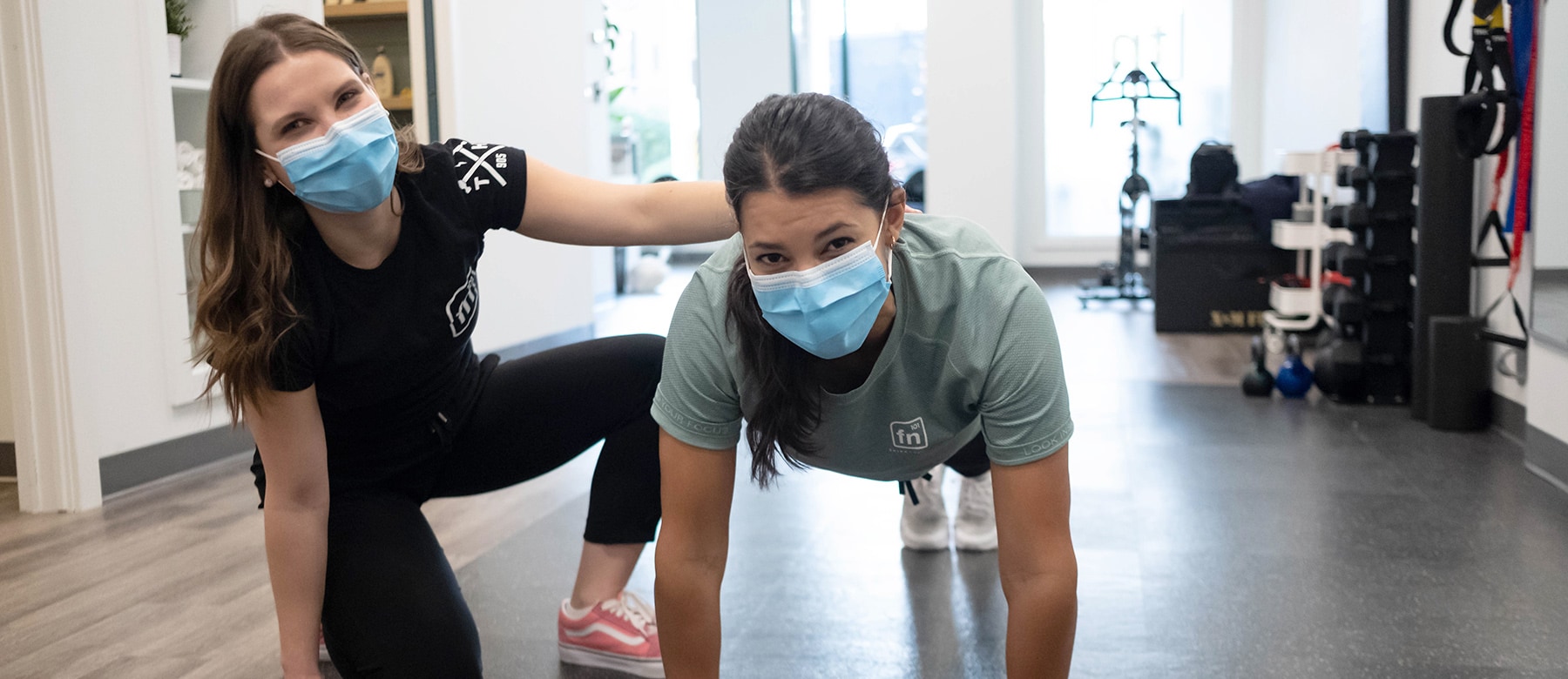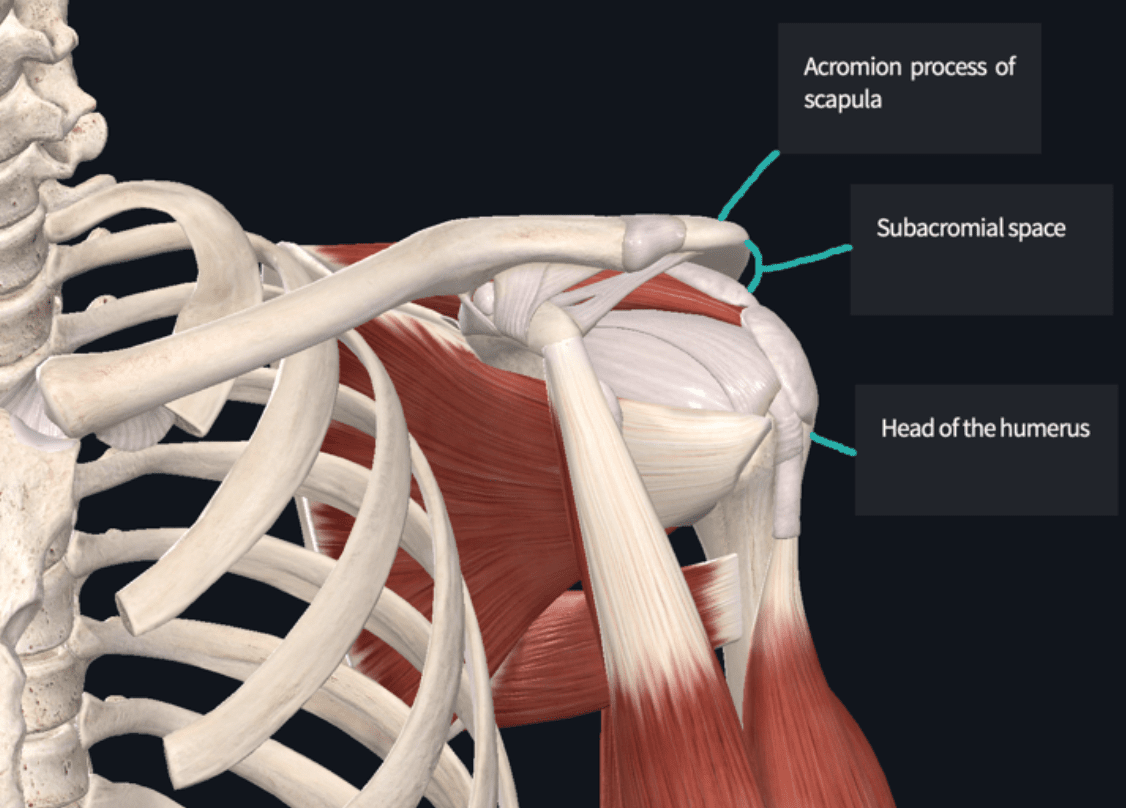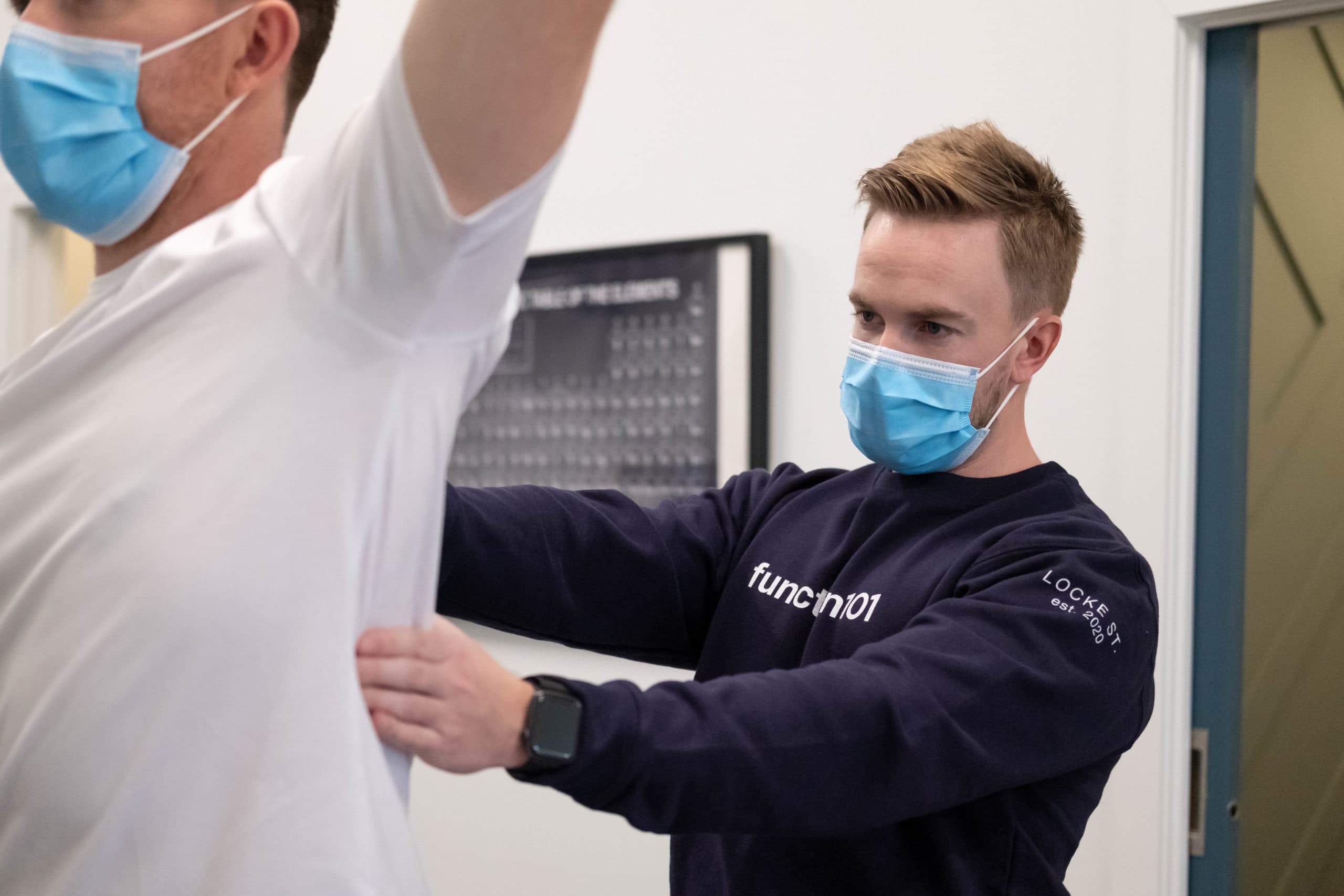Subacromial impingement, also known as shoulder impingement, is a common shoulder injury which classically presents as shoulder pain localized to the anterior (front of your shoulder) and/or radiating pain below the shoulder. Onset of symptoms can be slow or quick to develop with worsening pain typically with upper limb loading activities i.e. reaching, getting dressed, sleeping, etc. Patients with subacromial impingement frequently present to us as health care professionals for diagnosis and treatment, and we’re here to help!

First, a quick anatomy lesson:

The shoulder, or glenohumeral, joint is a ball-and-socket joint. The arm bone (humerus) forms the “ball”, and a cavity within the shoulder blade (glenoid fossa of scapula) forms the “socket”.
When we move our shoulder, this ball and socket joint needs to move together to achieve optimal range of motion and prevent injury. These movements are facilitated by the surrounding musculature. Specifically, serratus anterior and the upper and lower trapezius muscles help to rotate the shoulder blade upwards as we move our arms up. On the other hand, if we move our arms down, pectoralis minor, rhomboids, and levator scapulae rotate the shoulder blade downwards.
Since the shoulder is a very mobile joint, it also requires support from other structures to provide stability during motion. This is a job for the rotator cuff muscles (supraspinatus, infraspinatus, teres minor, and subscapularis) which play a vital role in centering the ball within the socket during movement. Without this function, the head of the humerus would move excessively during arm elevation, leading to problems such as subacromial impingement.
So, what is subacromial impingement?

Subacromial impingement is a common condition described as the narrowing of the space between the top of the shoulder blade (specifically the acromion) and the head of humerus. This narrowing applies pressure on the structures that run through that space (subacromial space), leading to irritation and pain. These structures include: the supraspinatus tendon, long head of biceps brachii tendon, and subacromial bursa.
Classification
Subacromial impingement can be classified into two types – structural or functional:
- Structural impingement can be caused by abnormal shape of the acromion, arthritis, or inflammation.
- Functional impingement, on the other hand, occurs due to muscle imbalances. Weakness of serratus anterior, rotator cuff, lower and middle trapezius and the deltoid muscles, along with tightness of the pectorals, levator scapulae, and upper trapezius muscles may lead to functional impingement.
Let’s work through a couple of examples to better understand how this is all related. If, for example, the muscles that rotate the scapula upwards were weak, then the head of the humerus would move more than the scapula during arm elevation. In turn, the subacromial space would become narrower. Similarly, if the downward rotators were tight, they could tip the scapula downwards, preventing necessary upward rotation to occur. Pectoralis minor, if tight, can tip the shoulder blade forward, which could also impact how the ball and socket interact during arm elevation.

How would I know if I had subacromial impingement?
Symptoms of impingement include:
- pain at the top and outside of shoulder
- symptoms which often get aggravated by overhead movements
- pain while lying on the affected shoulder
- weakness in the affected arm.
On your initial assessment, your physiotherapist or chiropractor will listen to your story and take a detailed health history, all of which will guide a thorough movement assessment. At this point, your therapist will be able to rule out injuries of other causes which someone may have when experiencing shoulder pain and identify if your symptoms are due to subacromial impingement. They will clearly communicate why you’re in pain, what’s the root cause, and potential solutions to get you out of pain quickly and keep you out of pain for the long run.
How can we help?

Management of shoulder impingement should be an individualized approach based on your main complaints and the contributing factors leading to this pain experience. Treatment usually consists predominately of both manual therapy and exercise.
Education: Education is always big part of your recovery journey. Make sure you find someone that you connect with and communicate well with! Individualized education on load management, the importance of adherence to active treatments like exercise therapy, and biomechanics that may contribute to the structural or functional impingement in your shoulder joint. By empowering our patients through education + movement, we hope to guide you along the recovery journey so that you can maintain the results of treatment in the long term and prepare you with the strategies for prevention.
Exercise: Exercise therapy is also a critical component of recovery with subacromial impingement. We’re in this together! You and your therapist will work on creating an individualized progressive strengthening program to improve the strength and load tolerance of weak muscles + release and stretch the tight structures around your shoulder joint.
Manual Therapy: Therapists may use manual therapy (active release technique, soft tissue therapy, joint mobilizations) in conjunction with exercise prescription. Due to the location of the shoulder blade as it sits on top of the rib cage, the mobility in the mid back region is commonly an important part of reducing symptoms and optimizing recovery. We always include a combined approach to treatment whether you are visiting chiropractic, physiotherapy, or massage therapy
Acupuncture: Clinicians may use acupuncture to reduce pain in patients with subacromial impingement. Our team of chiropractors and physiotherapists are trained in acupuncture ranging from dry needling, electroacupuncture, and traditional methods.
Taping: Scapular repositioning using kinesiotape in combination with exercise therapy may help you in immediate pain reduction and enhance your outcomes of exercise therapy in the short term.
Return to Activities: Using a progressive guided approach to return to sports and the activities that you love when the time is right will help you have a more successful outcome.
Here’s an example of what my go-to exercises include for rehabbing a client with subacromial impingement:
- Scap push ups
- Thoracic rotation open books
- Banded row with W
- Shoulder external rotation with dumbbell + shoulder press in sidelying
Book online with one of our chiro’s or physio’s today and follow us on instagram @function101locke for more educational content!



